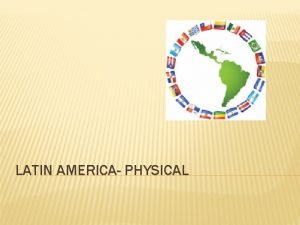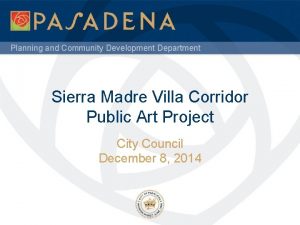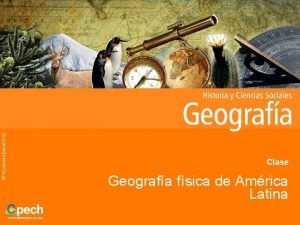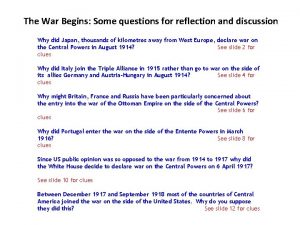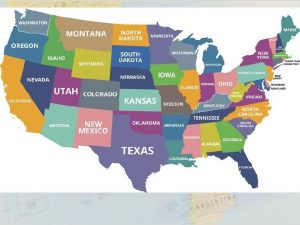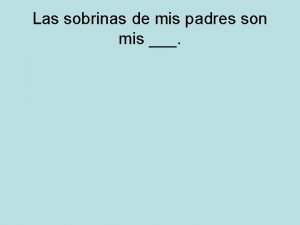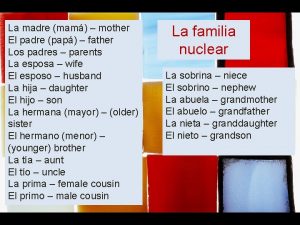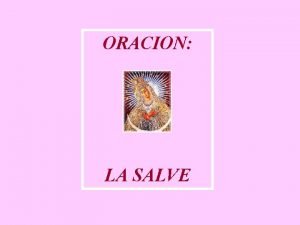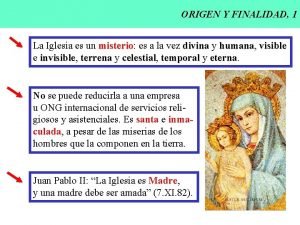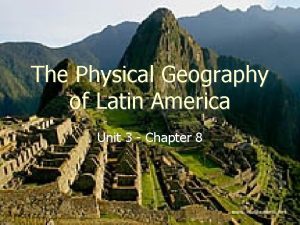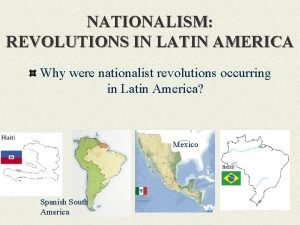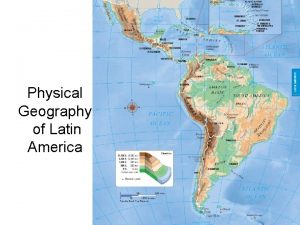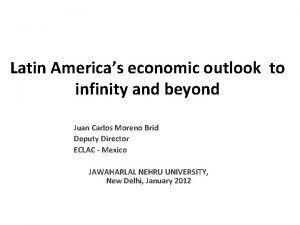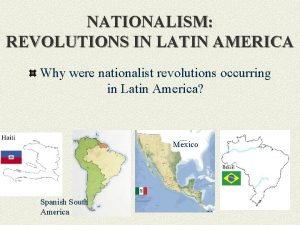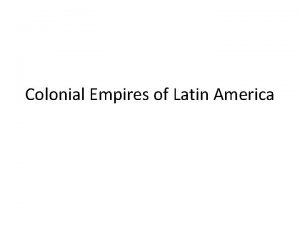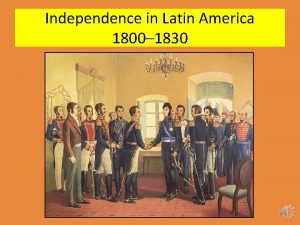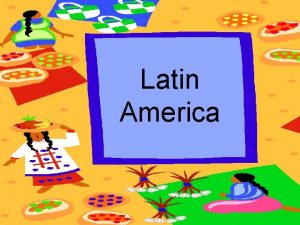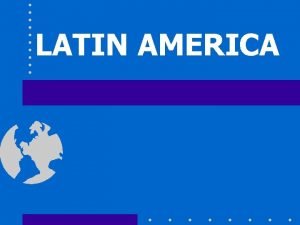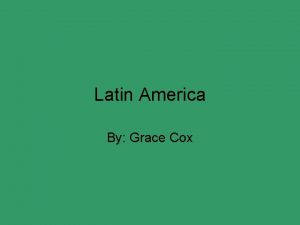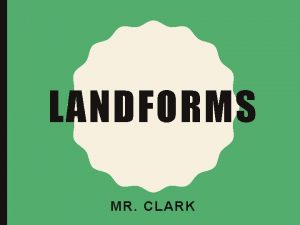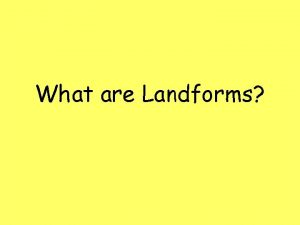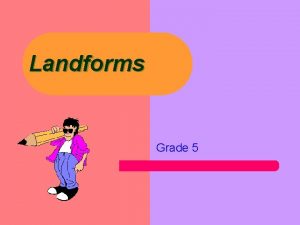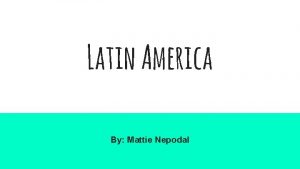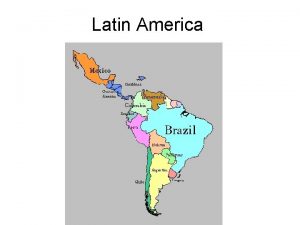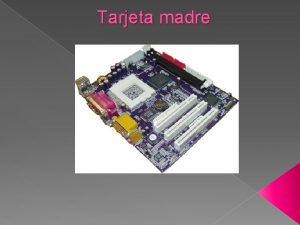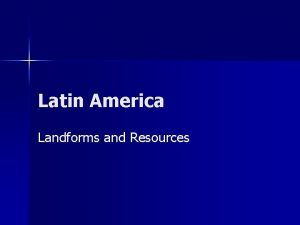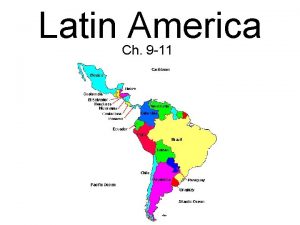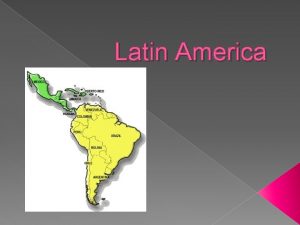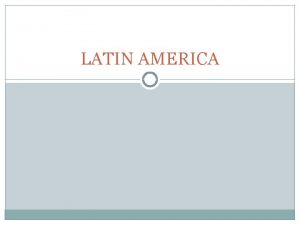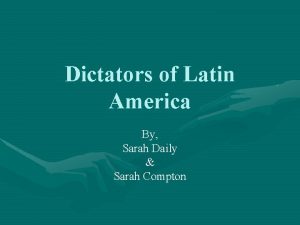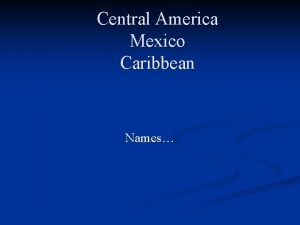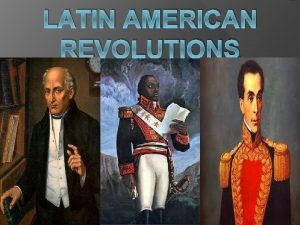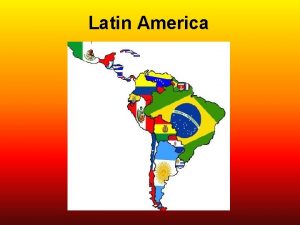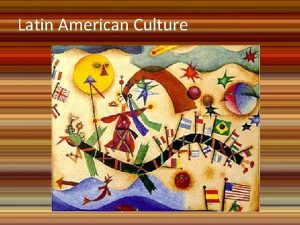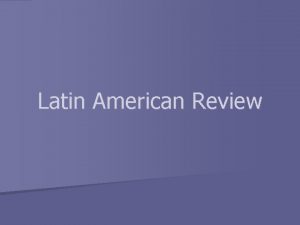LATIN AMERICA Sarah Urevig Mexico Landforms Sierra Madre

























- Slides: 25

LATIN AMERICA Sarah Urevig

Mexico ■ Landforms – Sierra Madre Occidental mountain range runs through Mexico mostly the west side and south side. – Copper Canyon – Sierra Madre del Sur is a mountain range in southern Mexico. – Baja Peninsula ■ Bodies of Water – Pacific and Atlantic Ocean – Gulf of Mexico – Caribbean Sea – Gulf of Tehuantepec – Gulf of California – – Balsas River The Rio Grande Lake Chapala Lake Cuitzeo

Mexico ■ Religions – Roman Catholic (88%) – Protestant (5%) ■ Languages – Most Mexicans speak Spanish but there are other indigenous languages

Mexico ■ Economic Strengths – The Mexican economy is trying to enhance efficiency and liberalizing investment governments. ■ Standard of living – GDP is $9, 000 – Life expectancy is 69(male) and 76(female). – 92% literacy rate – Lacks in health care options. – Urbanization level is 75% ■ Governments – Mexico’s government is divided into 3 levels, the Federal Union, the state government, and the municipal government. – The Federal Union has three branches, executive, legislative, and judiciary.

Mexico ■ History – A Spanish expedition came to Mexico to enrich themselves with gold. They ruled for 300 years. – During the French Revolution, Spanish power declined. Mexico gained Independence on September 16, 1810. – Mexico became a country on October 4, 1824. ■ Environmental Concerns – Drinking water sources are polluted in the north. – There is a lack of waste disposal facilities. – Groundwater depletion in the Valley of Mexico. ■ Key Element of Culture – The people of Mexico put high value on family, distant or close, and enjoy having celebrations with them.

Central America ■ Landforms – Central America is a land bridge connecting North and South America. – Sierra Madre de Chiapas mountain range. – Cordillera Isabelia mountain range. ■ Bodies of Water – Lake Nicaragua – Gulf of Fonseca – Gulf of Honduras – Panama Canal – Lake Managua

Central America ■ Religion – The majority of people are Roman Catholic. – The rest of the people are Protestant with some other trace religions. ■ Language – Most people speak Spanish. – Other people speak indigenous languages.

Central America ■ Economic Strengths – Central America is growing. – They project that their GDP will reach 4. 75%. ■ Standard of Living – Life expectancy is around 70 years old. – Literacy rate is 77. 3% – GDP is an average of $1, 716. 00. ■ Governments – Some of Central America is a republic. Guatemala has a constitutional democratic republic and so does Honduras. Costa Rica has a democratic republic and Panama has a constitutional democracy. Belize has a parliamentary democracy.

Central America ■ History – Spanish explorers arrived in the 1500’s. Settlers built towns and churches. – Independence came to Spanish Central America in the 1820’s. – In the early 1900’s, the US built the Panama Canal across central Panama. ■ Environmental Concerns – Deforestation is a major concern. – They also struggle with pollution and soil erosion. ■ Key Element of Culture – Latin America has many races because people were brought to Latin America during slavery of other migrations.

Bahamas ■ Landforms – The Bahamas are a group of coral islands. – The highest point is located on Cat Island, which is 206 feet above sea level. – There is one small river on the Andros island. ■ Bodies of water – Atlantic Ocean – Straits of Florida – Caribbean Sea

Bahamas ■ Religion – 70% Protestant – 13% Christian – 12% Roman Catholic ■ Language – They speak English.

Bahamas ■ Economic Strengths – The economy here depends on tourism. ■ Standard of Living – GDP is $25, 049. – Literacy rate is 98%. – Life expectancy is 70. ■ Governments – Unitary Parliamentary democracy and Constitutional monarchy. – Monarch is Elizabeth II – Governor-General is Sir Arthur Foulkes – Prime Minister is Hubert Ingraham

Bahamas ■ History – During proprietary rule, The Bahamas became a haven for pirates, including Blackbeard. – After American independence, Loyalists and their slaves moved to The Bahamas. These Loyalists established plantations on some islands and became a political force in the capital. ■ Environmental Concerns – coral reef decay – waste disposal – water pollution ■ Key Element of Culture – Regattas are important social events in many family island settlements. They usually feature one or more days of sailing by old-fashioned work boats, and a celebration.

Greater Antilles ■ Landforms – Islands – Volcanoes – Mountains – Pico Duarte on the island of Hispaniola. ■ Bodies of water – Caribbean Sea – Atlantic Ocean

Greater Antilles ■ Religion – The Taíno people spirituality centered on the worship of zemís which are spirits or ancestors. ■ Language – Taino Language

Greater Antilles ■ Economic Strengths – Strong health care and education systems. ■ Standard of Living – GDP is $20, 649. – Literacy rate is about 99%. – Life expectancy is about 79 years. ■ Governments – Democratic Republic.

Greater Antilles ■ History – Cuba was first inhabited by American Indians. – It was a Spanish colony until the Spanish. American War. ■ Environmental Concerns – High demands of water and energy resources. – Marine pollution. ■ Key Element of Culture – They enjoyed wearing gold pennants.

Lesser Antilles ■ Landforms – The Lesser Antilles are a group of islands in the Caribbean Sea. – Mountains ■ Bodies of water – Caribbean Sea – Atlantic Ocean

Lesser Antilles ■ Religion – Mainly Roman Catholic ■ Language – English is the official language.

Lesser Antilles ■ Economic Strengths – Manufacturing is important. ■ Standard of Living – GDP is about $17, 455. – Literacy rate is about 99%. – Life expectancy is about 70. ■ Governments – Republic

Lesser Antilles ■ History – Christopher Columbus encountered the island of Trinidad on 31 July 1498. – Trinidad and Tobago gained its independence from the United Kingdom on 31 August 1962. ■ Environmental Concerns – Pollution deforestation, soil erosion, and wildlife depletion. ■ Key Element of Culture – Trinidad and Tobago is the birthplace of calypso music and the steelpan.

South America ■ Landforms – Amazon Basin – Andes Mountains – Atacama Desert – Brazilian Shield – Cape Horn ■ Bodies of water – Pacific and Atlantic Ocean – Scotia Sea – Amazon River – Lake Titicaca

South America ■ Religion – Roman Catholic – Christianity – Protestant ■ Language – Most speak Spanish but English, Dutch, and French are also official languages.

South America ■ Economic Strengths – Imports and domestic production. ■ Standard of Living – GDP is about $9000. – Literacy rate is about 85%. – Life expectancy is about 77. ■ Governments – South American governments have drifted to the political left which supports social equality.

South America ■ History – In 1494, a treaty divided it between Spain and Portugal. – The Spanish focused on the west because the Inca lived there. – They gained independence between 1810 and 1830. ■ Environmental Concerns – Pollution and deforestation. ■ Key Element of Culture – South American nations have a rich variety of music.
 Latin america physical features map
Latin america physical features map Why called latin america
Why called latin america Landforms in latin america
Landforms in latin america Sierra madre planning department
Sierra madre planning department Sierra madre mountains map
Sierra madre mountains map Sierra madre oriental y occidental mapa
Sierra madre oriental y occidental mapa Map of mexico and central america
Map of mexico and central america Latin america map physical features
Latin america map physical features Son los padres de mis tios
Son los padres de mis tios La madre de mi madre es mi _____.
La madre de mi madre es mi _____. Dios te salve reina y madre
Dios te salve reina y madre El origen de la iglesia es
El origen de la iglesia es Mexico brazil latin american cbdcsenglercoindesk
Mexico brazil latin american cbdcsenglercoindesk Rap of the map of the us
Rap of the map of the us Repetition in let america be america again
Repetition in let america be america again Countries between south america and africa
Countries between south america and africa Performance e body art
Performance e body art Unit 3 latin america
Unit 3 latin america How were nationalist revolts in latin america
How were nationalist revolts in latin america Physical geography of latin america worksheet answers
Physical geography of latin america worksheet answers Chapter 8: the physical geography of latin america answers
Chapter 8: the physical geography of latin america answers La navidad in spain
La navidad in spain Mendel latin america 15m series infinity
Mendel latin america 15m series infinity Class system in latin america
Class system in latin america Colonial empires in latin america
Colonial empires in latin america Latin america hierarchy
Latin america hierarchy


